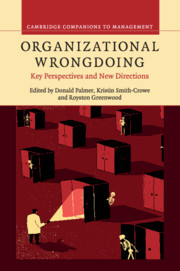Book contents
- Frontmatter
- Contents
- List of figures
- List of tables
- List of contributors
- Foreword
- 1 The imbalances and limitations of theory and research on organizational wrongdoing
- 2 On taking the theoretical substance of outcomes seriously: a meta-conversation
- 3 Wrong paths to right: defining morality with or without a clear red line
- 4 From market enablers to market participants: redefining organizational and political-legal arrangements and opportunities for financial wrongdoing,1930s–2000
- 5 Wrongdoing and market development: an examination of the distinct roles of trust and distrust
- 6 Bad apples, bad barrels and bad cellars: a “boundaries” perspective on professional misconduct
- 7 S/he blinded me with science: the sociology of scientific misconduct
- 8 Social networks and organizational wrongdoing in context
- 9 Falling stars: celebrity, infamy, and the fall from (and return to) grace
- 10 Compensation and employee misconduct: the inseparability of productive and counterproductive behavior in firms
- 11 Beware of organizational saints: how a moral self-concept may foster immoral behavior
- 12 “Is it me? Or is it me?” The role of coactivated multiple identities and identifications in promoting or discouraging workplace crimes
- 13 Consequences of organizational misconduct: too much and too little punishment
- 14 Who bears the brunt? A review and research agenda for the consequences of organizational wrongdoing for individuals
- 15 Organizational wrongdoing and media bias
- 16 Ethical learning: releasing the moral unicorn
- Index
- References
16 - Ethical learning: releasing the moral unicorn
Published online by Cambridge University Press: 05 July 2016
- Frontmatter
- Contents
- List of figures
- List of tables
- List of contributors
- Foreword
- 1 The imbalances and limitations of theory and research on organizational wrongdoing
- 2 On taking the theoretical substance of outcomes seriously: a meta-conversation
- 3 Wrong paths to right: defining morality with or without a clear red line
- 4 From market enablers to market participants: redefining organizational and political-legal arrangements and opportunities for financial wrongdoing,1930s–2000
- 5 Wrongdoing and market development: an examination of the distinct roles of trust and distrust
- 6 Bad apples, bad barrels and bad cellars: a “boundaries” perspective on professional misconduct
- 7 S/he blinded me with science: the sociology of scientific misconduct
- 8 Social networks and organizational wrongdoing in context
- 9 Falling stars: celebrity, infamy, and the fall from (and return to) grace
- 10 Compensation and employee misconduct: the inseparability of productive and counterproductive behavior in firms
- 11 Beware of organizational saints: how a moral self-concept may foster immoral behavior
- 12 “Is it me? Or is it me?” The role of coactivated multiple identities and identifications in promoting or discouraging workplace crimes
- 13 Consequences of organizational misconduct: too much and too little punishment
- 14 Who bears the brunt? A review and research agenda for the consequences of organizational wrongdoing for individuals
- 15 Organizational wrongdoing and media bias
- 16 Ethical learning: releasing the moral unicorn
- Index
- References
Summary
Of all the legendary animals of art, folklore, and literature, the Unicorn is the one with the greatest hold on our imaginations. Other fabulous beasts are clearly inventions, existing only in a mythical landscape of our own collective creation. But the Unicorn strikes us as more than imaginary. It seems possible, even probable – a creature so likely that it ought to exist.
(Nancy Hathaway 1987: 3)Unbounded ethicality and unbounded rationality are the unicorns of social science: persistent in our imaginations and representative of the beauty we crave in the world, but lacking empirical support. Like the unicorn, such behavioral elegance feels like it “ought to exist.” The concepts of bounded rationality (Simon 1957) and bounded ethicality (Chugh, Bazerman, and Banaji 2005; Chugh and Kern, working paper) offer more empirically valid representations of reality, reminding us not only that we and others are prone to departures from rationality and ethicality in our behavior but that these departures are the outcome of systematic and ordinary psychological processes.
Still, despite the reveal of the illusion of the moral unicorn, we cling to what it offers, an alternate reality in which good people are ethically infallible, and in which we (all of us) are among the good. Many people care about being ethical (Aquino and Reed 2002; Higgins 1987; Mazar, Amir, and Ariely 2008; Nisan 1991). And, not only do people care about being ethical, they also believe that they are ethical (Tenbrunsel 1998). Despite caring about ethicality and believing in their own ethicality, ample evidence suggests that there is a significant gap between how people view their own ethicality and how ethically people actually behave (Bazerman and Tenbrunsel 2011). But, our “bounded ethicality” is often outside of awareness (Chugh et al. 2005; Tenbrunsel and Smith-Crowe 2008), allowing for the illusion of the unicorn to persist despite evidence contradicting its existence.
The evidence for this gap is significant. Most of us believe that we are more ethical than the majority of our peers, which is a statistically untenable belief for at least some of us (Tenbrunsel 1998). We tend to mispredict our future behavior, overestimating the likelihood that we would behave in socially desirable ways (Epley and Dunning 2000). We overclaim credit for group work (Caruso, Epley, and Bazerman 2006).
- Type
- Chapter
- Information
- Organizational WrongdoingKey Perspectives and New Directions, pp. 474 - 503Publisher: Cambridge University PressPrint publication year: 2016
References
- 7
- Cited by

